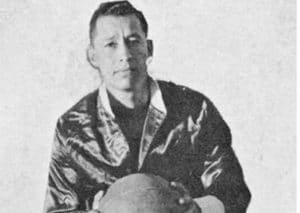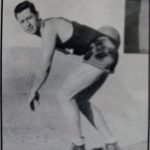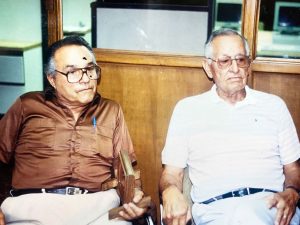Early life
 Francisco “Kiko” Martinez Cordero was born on June 20, 1912 to Francisco Martinez Sr. & Josefina Cordero Martinez.
Francisco “Kiko” Martinez Cordero was born on June 20, 1912 to Francisco Martinez Sr. & Josefina Cordero Martinez.
Martinez first gained fame at El Paso High where he led the Tigers to great success in basketball in the late 20s. A clever, smooth player, Kiko was a purist who loved the game from the first time he played. On the dusty, rough-and-tumble playgrounds of El Paso, he played endless pick-up games. When alone, he practiced tirelessly and mastered the fundamentals–dribbling, passing, footwork and set shooting. But it was his strong will and coolness that stood out. Teammates and opponents saw the confidence and knew that Martinez didn’t buckle under pressure.
His parents, natives of Mexico, moved to El Paso where Kiko was born in 1911. This heritage bestowed young Martinez with dual Mexican-American citizenship — a situation he fully enjoyed.
Los Dorados
Following high school, Martinez went to work in El Paso and played amateur basketball on evenings and weekends. In the early 1930s, Kiko was offered a job in Chihuahua. Part of the deal was to play for Los Dorados, a club team sponsored by wealthy Mexican businessmen. At the time, Mexico was struggling to field a basketball team to compete in the 1936 Olympic Games in Berlin. At those Games, basketball was for the first time to be an Olympic sport.
1936 Berlin Summer Olympics
 Played outdoors on a clay tennis court dusted with sand, sawdust, and salt, Martinez and the Mexicans were used to the conditions and played well. They ingenuity during these Olympic Games quite possibly gave birth to the current fast break machine. Kiko would later recreate the fast tempo fast break scheme with New Mexico A&M. They finished with the Bronze medal behind the U.S. and Canada. The medals were awarded by Dr. James Naismith. It was Mexico’s first and still only medal in Olympic history in the sport of basketball.
Played outdoors on a clay tennis court dusted with sand, sawdust, and salt, Martinez and the Mexicans were used to the conditions and played well. They ingenuity during these Olympic Games quite possibly gave birth to the current fast break machine. Kiko would later recreate the fast tempo fast break scheme with New Mexico A&M. They finished with the Bronze medal behind the U.S. and Canada. The medals were awarded by Dr. James Naismith. It was Mexico’s first and still only medal in Olympic history in the sport of basketball.
First round | Mexico vs Belgium W 32-9
Second Round | Mexico vs Philippines L 32-30
Third Round | Mexico vs Japan W 28-22
Quarterfinals | Mexico vs Italy W 24-17
Semifinals | Mexico vs United States L 25-10
Bronze Medal Match | Mexico vs Poland W 26-12
Did You Know…
Perhaps the FAST BREAK was born in Berlin 1936 thanks to the Mexican National Team and its ingenuity.
New Mexico A&M Aggies
Hot Recruit
Recruited to NM A&M by Coach Jerry Hines in 1936, Martinez was a star from the first day on campus. In 1936-’37, he teamed with Aggie legends Anastacio ‘Hooky’ Apodaca and ‘cousin’ Lauro Apodaca on a squad that went 22 and 5 and won the Border Conference Championship. Hooky and Lauro both made All Conference that year.
 For the next two years, team captain Martinez was at the throttle of the great fast-breaking Aggie teams that included Pecos Finley, Pucker Wood, Joe Jackson, and Mel Ritchey. All were New Mexicans or West Texans. They won two more Border Conference titles and compiled a sparkling record of 42 and 7. From 1936-39, the Aggies were undefeated against New Mexico (12-0) and Texas-El Paso (10-0). Kiko was All Border Conference in 1938 and 1939, and finished a close second in conference scoring in both years.
For the next two years, team captain Martinez was at the throttle of the great fast-breaking Aggie teams that included Pecos Finley, Pucker Wood, Joe Jackson, and Mel Ritchey. All were New Mexicans or West Texans. They won two more Border Conference titles and compiled a sparkling record of 42 and 7. From 1936-39, the Aggies were undefeated against New Mexico (12-0) and Texas-El Paso (10-0). Kiko was All Border Conference in 1938 and 1939, and finished a close second in conference scoring in both years.
World War II
Did You Know…
Kiko Martinez once scored 21pts in 4 minutes in a game.
Kiko saw duty in Clovis and Carlsbad as a civil engineer at military air fields. He married Marta Baca on St. Patrick’s Day, March 17, 1941. His eldest son, Kiko Martinez Jr, was born on February 15, 1942.
Los Alamos
Kiko and his family moved to Los Alamos where he worked at Zia Company for the next 20 years. During this time, Kiko continued to play amateur basketball and became one of the state of New Mexico’s top high school referees and annually called the state’s basketball high school tournaments in springtime.
Back to El Paso
 Around 1965, Kiko and family moved back to El Paso, TX. He continued to work as a civil engineer until his retirement. He would continue his basketball teaching working with kids at the local El Paso YMCA and teach his grandkids about the art of basketball.
Around 1965, Kiko and family moved back to El Paso, TX. He continued to work as a civil engineer until his retirement. He would continue his basketball teaching working with kids at the local El Paso YMCA and teach his grandkids about the art of basketball.
In 1970, he was inducted into the New Mexico State University Athletic Hall of Fame. His portrait can be seen above the main entrance in the Pan American Center.
In 1993, he fell ill with cancer and peacefully passed away on December 1, 1993. He was 82 years old.
Awards and Recognition
New Mexico State Athletic Hall of Fame – 1970
El Paso Athletic Hall of Fame – 1994
State of Chihuahua Athletic Hall of Fame
City of Juarez Athletic Hall of Fame

